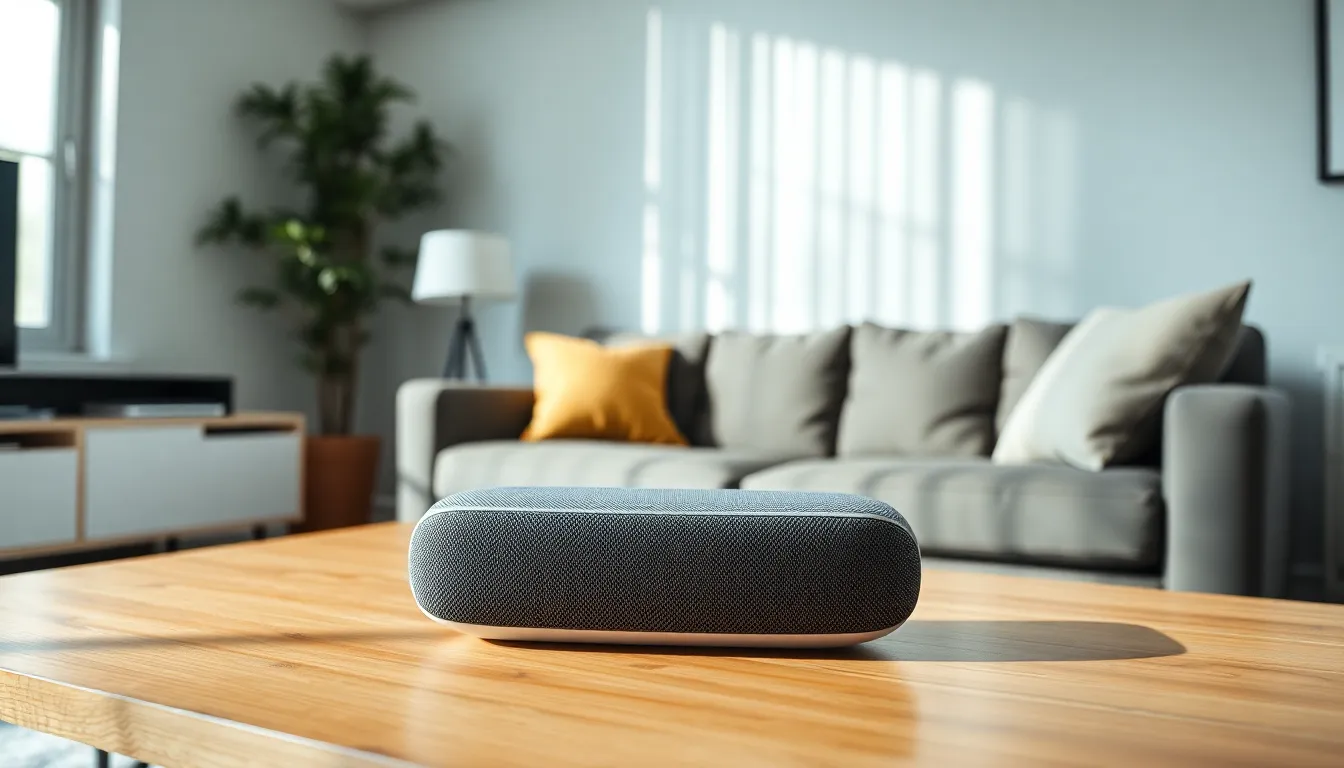Imagine waking up to the gentle hum of your favorite tunes, the aroma of freshly brewed coffee, and a voice that knows exactly what you need. Smart speakers have transformed homes into tech-savvy havens, bringing convenience and entertainment right to your fingertips. These little gadgets don’t just play music; they can control your lights, answer your burning questions, and even tell you a joke or two—because who doesn’t love a good dad joke to start the day?
Table of Contents
ToggleOverview of Smart Speakers
Smart speakers represent a significant technological advancement in home automation. These devices integrate voice recognition technology, enabling users to interact through simple voice commands. Music playback, home lighting control, and query responses exemplify their multifunctionality.
Voice assistants like Amazon Alexa, Google Assistant, and Apple Siri form the core of many smart speakers. They provide users with access to a vast array of services, from setting reminders to streaming music playlists. Specific models, such as the Amazon Echo and Google Nest, showcase their adaptability within smart home ecosystems.
Automation features contribute to their popularity. Through integration with various smart home devices, users can monitor security cameras and adjust thermostats seamlessly. Different applications enhance personalization, allowing users to customize settings based on routines.
Privacy concerns accompany these devices as well. Continuous listening capabilities raise questions about data security. Users often seek information on privacy measures, such as the option to mute microphones or delete voice recordings. Understanding these aspects remains essential for responsible usage.
The growth of smart speakers reflects trends in consumer preferences for convenience and connectivity. Research indicates that 60% of households have adopted these devices, highlighting their role in modern living. Usage patterns reveal their value in daily activities, from scheduling daily tasks to providing weather updates.
Smart speakers offer a blend of convenience and technology that reshapes household interactions. Their versatility and range of features establish them as central components in the contemporary smart home landscape.
Key Features of Smart Speakers

Smart speakers incorporate several key features that enhance their functionality and user experience. They offer innovative solutions for everyday tasks, improving convenience and connectivity in homes.
Voice Recognition Technology
Voice recognition technology enables smart speakers to understand spoken commands accurately. It utilizes advanced algorithms to process natural language, allowing seamless interaction. Users can ask questions or request actions without needing physical input. The precision of this technology caters to different accents and dialects, improving accessibility for diverse populations. Leading voice assistants, including Amazon Alexa, Google Assistant, and Apple Siri, capitalize on this technology to execute commands effectively. Smart speakers can learn from user interactions, adapting to preferences and improving responsiveness over time.
Smart Home Integration
Smart home integration enhances the functionality of smart speakers within connected ecosystems. These devices serve as central hubs for controlling various smart appliances, like thermostats, lights, and security systems. Compatibility with numerous brands allows users to customize their home automation experience. Users can create routines that automate tasks, such as adjusting lighting based on time of day. Smart speakers also facilitate remote monitoring, enabling control of devices from anywhere via mobile apps. This integration not only streamlines daily activities but also promotes energy efficiency in households.
Popular Smart Speaker Brands
Smart speakers lead the modern tech landscape with various innovative brands. Each brand offers unique features and capabilities that cater to different user preferences.
Amazon Echo
Amazon Echo stands out for its integration with Alexa, enhancing usability through voice commands. It offers multiple models like the Echo Dot and Echo Show, providing options for sound quality and display features. The device excels at home automation, allowing users to control smart home gadgets effortlessly. Furthermore, with compatibility for various music streaming services, it creates a versatile listening experience. Research shows that Echo users appreciate its ability to facilitate daily routines, such as setting reminders or checking the weather.
Google Nest Audio
Google Nest Audio emphasizes superior sound quality and smart integration with Google Assistant. Users benefit from its ability to answer queries, manage tasks, and control compatible smart devices. The design focuses on being aesthetically pleasing while delivering powerful audio performance. Additionally, it provides multi-room audio capabilities, allowing seamless music playback throughout the house. Reports indicate its popularity stems from its adaptability and the rich ecosystem of Google services, offering a comprehensive smart home experience.
Apple HomePod
Apple HomePod appeals to users seeking high-fidelity audio quality paired with Siri’s intelligent assistance. The device features an elegant design and impressive sound engineering, making it a choice for audiophiles. HomePod’s integration with Apple Music provides an enriched listening experience, and it excels in recognizing voices for personalized responses. Moreover, users appreciate its ability to connect with other Apple devices, creating an interlinked ecosystem. Data indicates that it draws interest from users who prioritize quality audio and established Apple services.
Advantages of Using Smart Speakers
Smart speakers offer significant convenience, transforming how individuals interact with technology in daily life. These devices streamline tasks such as playing music, adjusting lights, and checking the weather, simplifying routines and enhancing efficiency.
Users benefit from voice control, allowing hands-free operation that fits seamlessly into busy lifestyles. Voice recognition technology has advanced, providing accurate responses and understanding varied accents.
Interconnectivity with smart home systems makes these speakers central hubs for managing devices, such as security cameras and thermostats, creating an integrated living environment. Smart speakers allow users to create automation routines, streamlining daily tasks and promoting energy conservation.
Personalization features further enhance user experience by adapting to preferences and habits. For example, recurring reminders and favorites make information easily accessible.
Entertainment options expand with smart speakers, offering access to music, podcasts, and audiobooks directly through voice commands. Streaming services integrate well, letting users enjoy varied content without needing other devices.
Data from consumer research indicates that 60% of households incorporate smart speakers into their homes, reflecting their growing popularity and perceived value. Security features, such as monitoring systems and alerts, increase the appeal of these devices for safety-conscious users.
Privacy considerations arise with continuous listening capabilities, prompting users to explore settings for enhanced control over data. However, many appreciate the trade-off for convenience and smart automation.
Overall, smart speakers significantly enhance modern living, providing diverse functionalities that cater to various lifestyle needs. They act as versatile tools that contribute to a more connected and efficient home environment.
Potential Drawbacks of Smart Speakers
Privacy concerns arise with the continuous listening features of smart speakers. Users may feel uneasy knowing these devices could potentially record conversations unintentionally. Data security represents another significant drawback, as breaches related to personal information have happened in various technological devices.
Dependence on internet access for full functionality presents a limitation. Should the internet connection be unstable or lost, smart speakers may become inoperative. Additionally, voice recognition technology, while advancing, may still struggle with accents or background noises, resulting in miscommunication.
Limited compatibility can restrict users with devices outside standard smart ecosystems. Not all smart speakers work seamlessly with every appliance, which can hinder the desired automation experience. Furthermore, some models introduced proprietary software, which lessens cross-compatibility with other brands.
User frustration with over-reliance on specific voice commands can also occur. Smart speakers sometimes require very precise instructions, leading to inconvenience. Battery life, for portable models, may limit their usability in certain situations, particularly when used away from power outlets.
Additionally, children’s exposure raises concerns regarding reliance on technology. Their interaction with smart speakers might reduce face-to-face communication and critical thinking skills. Perceived obsolescence, where newer models are frequently released, may urge users to upgrade more often than necessary.
Maintenance of smart speakers involves software updates, which can be cumbersome. These updates might pose inconvenience when they disrupt operational workflows or require user intervention.
Smart speakers have undeniably transformed the way people interact with technology in their homes. Their convenience and versatility make daily tasks more manageable while enhancing entertainment options. As these devices continue to evolve, they’re likely to become even more integral to smart home ecosystems.
Despite some privacy concerns and limitations, the benefits of smart speakers often outweigh the drawbacks for many users. Their ability to streamline routines and provide hands-free assistance aligns perfectly with modern lifestyles. As consumers increasingly embrace these innovations, smart speakers will play a pivotal role in shaping the future of home automation and connectivity.



